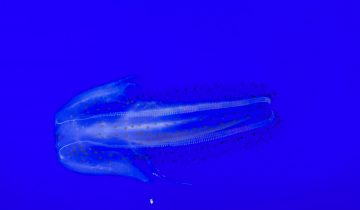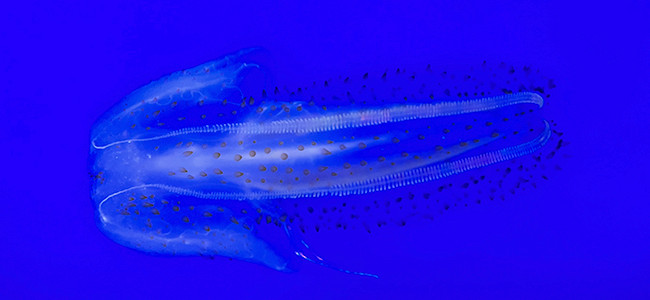Leucothea pulchra, commonly known as the beautiful sea goddess or spotted comb jelly, is a species of lobate ctenophores belonging to the family Bolinopsidae and the phylum Ctenophora. The genus name, Leucothea, comes from Greek mythology, where Leucothea is a sea goddess, while the specific epithet pulchra means ‘beautiful‘ in Latin, referring to its ethereal and delicate appearance. This species is found in the eastern Pacific Ocean, with a distribution ranging from Central California to the Gulf of California. It inhabits pelagic waters, generally from the surface down to 200 meters deep, and is more common in open ocean areas with high plankton productivity.
Leucothea pulchra is a large ctenophores, reaching up to 250 mm in length. Its body is elongated and delicate, translucent white in color, with orange-brown papillae arranged along its external surface. These papillae give it a characteristic spotted appearance that helps in its identification. It has two prominent lobes on the sides, used for propulsion and prey capture. Like all ctenophores, it has rows of comb-like cilia that beat to refract light and produce an iridescent, rainbow-like effect. It can be distinguished from similar species such as Bolinopsis infundibulum by the presence of pigmented papillae and a more robust, lobe-segmented body morphology.
Leucothea pulchra feeds primarily on zooplankton, with a diet dominated by copepods and other small crustaceans. Its lobes function as passive capture surfaces: prey becomes trapped by the filamentous tentacles arranged between the lobes, which are covered with adhesive cells called colloblasts. Once immobilized, the prey is transported to the central mouth through coordinated movements of the lobes and tentacles. This feeding strategy is highly efficient in plankton-rich waters.
Reproduction in Leucothea pulchra is sexual, and individuals are simultaneous hermaphrodites. They release sperm and eggs into the water, where external fertilization occurs. The eggs develop into a larva known as a cydippid, morphologically similar to the adult, which undergoes a series of transformations until reaching maturity. Although no specific reproductive season has been documented, their appearance in large numbers at certain times of the year suggests seasonal reproduction, possibly linked to spring and summer food availability.
In addition to its extraordinary beauty, Leucothea pulchra has attracted scientific interest due to its structural fragility, often described as ‘barely organized water‘. This organism is so delicate that it easily disintegrates when handled, making its study and captive rearing difficult. However, aquariums such as the Monterey Bay Aquarium have recently succeeded in raising it under controlled conditions, allowing it to be displayed to the public. Ecologically, this species plays an essential role in the pelagic food web as a plankton predator and a possible prey item for gelatinous fish or juvenile cephalopods. Although no specific symbiotic relationships are known, its presence may attract gelatinous predators such as Beroe forskalii, a ctenophore specialized in preying on other ctenophores.
Photos:



 from
from